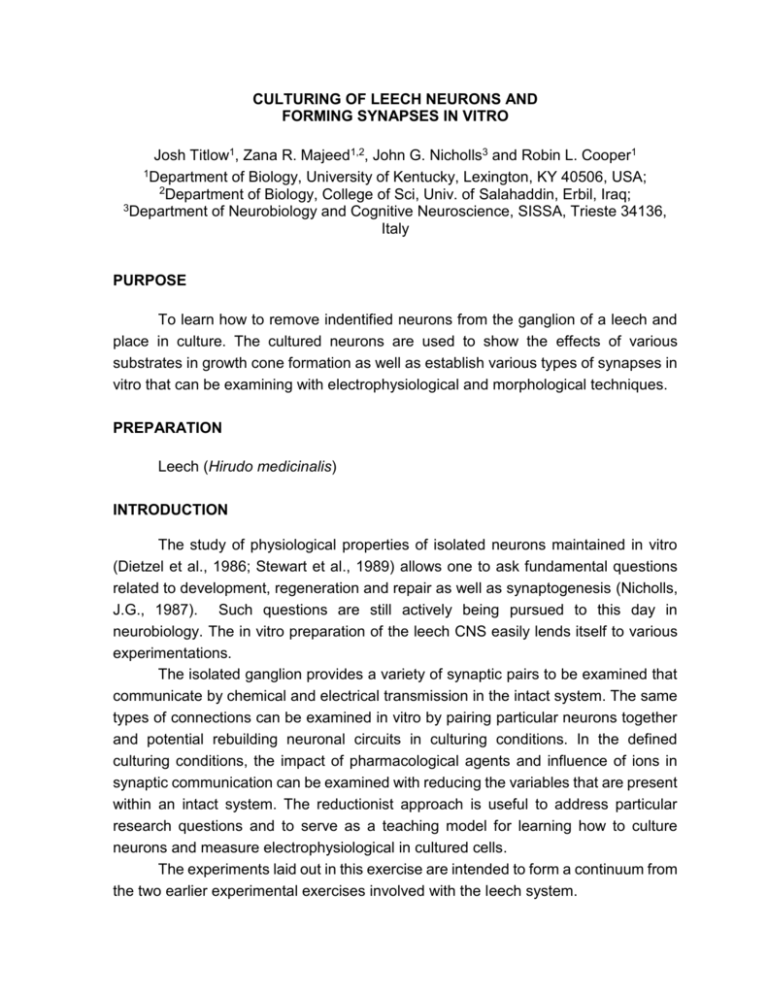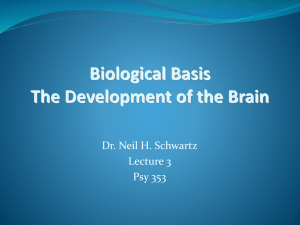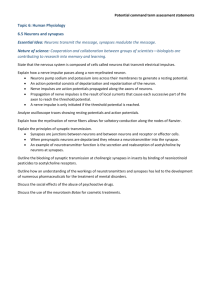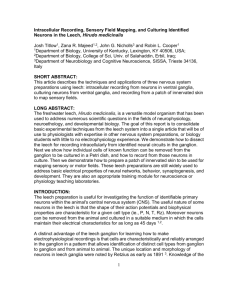MS WORD file
advertisement

CULTURING OF LEECH NEURONS AND FORMING SYNAPSES IN VITRO Josh Titlow1, Zana R. Majeed1,2, John G. Nicholls3 and Robin L. Cooper1 1Department of Biology, University of Kentucky, Lexington, KY 40506, USA; 2Department of Biology, College of Sci, Univ. of Salahaddin, Erbil, Iraq; 3Department of Neurobiology and Cognitive Neuroscience, SISSA, Trieste 34136, Italy PURPOSE To learn how to remove indentified neurons from the ganglion of a leech and place in culture. The cultured neurons are used to show the effects of various substrates in growth cone formation as well as establish various types of synapses in vitro that can be examining with electrophysiological and morphological techniques. PREPARATION Leech (Hirudo medicinalis) INTRODUCTION The study of physiological properties of isolated neurons maintained in vitro (Dietzel et al., 1986; Stewart et al., 1989) allows one to ask fundamental questions related to development, regeneration and repair as well as synaptogenesis (Nicholls, J.G., 1987). Such questions are still actively being pursued to this day in neurobiology. The in vitro preparation of the leech CNS easily lends itself to various experimentations. The isolated ganglion provides a variety of synaptic pairs to be examined that communicate by chemical and electrical transmission in the intact system. The same types of connections can be examined in vitro by pairing particular neurons together and potential rebuilding neuronal circuits in culturing conditions. In the defined culturing conditions, the impact of pharmacological agents and influence of ions in synaptic communication can be examined with reducing the variables that are present within an intact system. The reductionist approach is useful to address particular research questions and to serve as a teaching model for learning how to culture neurons and measure electrophysiological in cultured cells. The experiments laid out in this exercise are intended to form a continuum from the two earlier experimental exercises involved with the leech system. METHODS Cell identification First identify neurons on the ventral side of an isolated leech ganglion. Using Figure 1 to locate the Retzius (Rz), touch (T), pressure (P), and nociceptive (N) cells in your preparation. Make sure to adjust the lighting and preparation for a crisp, clear image. Figure 1: the arrangement of neurons and the evoked action potentials for some of the sensory neurons (from Blackshaw, 1981 modified from Nicholls and Baylor, 1968). Culturing of identified single leech neurons and in vitro synaptogenesis. For the following procedure one should follow the methods outlined in the article by Liu and Nicholls (1989). A brief outline given below is provided to help you follow each step. A detailed list of chemicals and materials needed for this part of the experiment is also provided. Take a leech and pin it out with the ventral side up (Figure 1). Cut through the skin to the muscle layer from the head end to the tail end with a scalpel. With scissors cut the muscle to expose the ventral sinus which contains the nerve cord. Always keep the CNS moist with leech saline. Now, cut the stocking to expose the nerve cord from the ventral side. When cutting the stocking from the ganglionic roots, leave some stocking attached to these roots for pinning out the ganglia later on (Figure 2). Depending on the intended use, one can remove one ganglion at a time or the entire nerve cord at once. Figure 2: Exposing the ventral nerve cord (VNC). Top panel illustrates the careful cutting away of the stocking with one edge of the scissors within the stocking while cutting along the length of the VNC. Pin the ganglia ventral side up in a clean dish containing L-15 with FCS (Sylgard bottom, Figure 3). Pin the roots so that the ganglia are slightly stretched. One should be able to see the 2 large Rz cells. If the ganglia are cloudy, do not use them. With fine scissors, nick the glial capsule at one end and slip one scissors blade end under the capsule. Figure 3: With fine pins stretch out the roots and connectives so the ganglia are taut and flat. Cut across the glial capsule. (Figure 4..with dotted line for cut) Now, the cell bodies should be like grapes sticking out from the opened ganglia (Figure 4B). The volume of L-15 containing FCS should be about 2ml. Add 100 µl aliquot of the Collagenase/Dispase to the dish and place on a shaker for 15 min. Examine cells and blow the medium around the exposed cell bodies. Place back on the shaker for another 15 min or longer if the cells do not come out with slight sucking. Figure 4. Desheathing the ganglion to remove individual cell bodies. (A) The glial sheath should be carefully cut across the ganglion to avoid damaging cells of interest. The red line indicates a cut to avoid hitting the soma of the Rz neurons. Opening the sheath allows access to the digestive enzymes to the connective matrix. (B) Healthy cell bodies bulging out of the ganglion after the glial sheath has been opened. The sucking pipette opening should be just slightly larger than the cell body diameter. For Rz cells in an adult leech, the diameter should be around 50 µm. It is best to make a variety of pipettes with different diameters. These pipettes can be made out of the 30-30-0 glass or something similar. It does appear that using a pipette without a filament decreases the changes of the cells sticking inside the pipette. These pipettes should be stored in a bottle containing 80% ethanol (EtOH), to kill any bacteria, using a cotton ball at the bottom to protect the tips from chipping. Remember to wash the EtOH out of the pipette with medium before sucking on cells. After the enzyme treatment, wash out the enzyme-containing medium with L-15 (with FCS) 2 times. Identify your cells of interest and gently suck them into the pipette. Discharge the sucked cells into another dish which contains L-15 (with FCS). Until now, all procedures were nonsterile. Now, we need to make arrangements for a sterile set-up. In a sterile hood, place 3 to 4 large drops of sterile L-15 (with FCS) in different locations inside a sterile Petri dish. Pipette the cells into one of the before-mentioned drops, blowing them around in the drop to wash them. Repeat this in series in 3 or 4 drops of medium. Then place cells in a clean Petri dish filled with L-15 (with FCS). Let the cells stand for an hour or even over night at room temperature. Afterwards the clean cells can be plated. By leaving the cells for a few hours or overnight the extracellular matrix comes off easily. If one wants long stumps left intact (Figure 5), it is best to plate the cells right after they have been removed and washed because the stumps will retract if left overnight. The microwell culture dishes work well in protecting the cells from being dislodged when moving the dish around. When coating the microwell dishes, the substrate should be sterile. The substrate can either be left overnight to evaporate dry or just for a few hours before plating. After the dish has been coated, wash the dish gently with sterile water and then with a small amount of the L-15 medium. Remember to use the L-15 solution without the FCS added to allow the cells to adhere to the dish. The medium can be gently changed to L-15 with FCS after the cells have adhered to the substrate. If the cells are to be used a few hours after plating, then switching the medium to L-15 with FCS is not necessary. Figure 5. Cultured leech neurons. (A) Cells are aspirated from the ganglion and cultured on a dish containing a culture media. (B) Placing multiple cells near one another will increase the rate of synaptogenesis between identifiable neurons. Here the stumps of two neurons are almost touching. Scale bar 100 µm. Cells can be positioned next to each other at the time of plating to induce rapid synaptogenesis (Figure 5B). Synaptic contacts are established most rapidly if the stumps of the cells' processes are touching. After 24 hrs synaptic responses are able to be measured in pairing of neurons. Depending on the type of cells used there are different types of synaptic responses one will measure. Electrophysiological measures of neurons in culture The same procedures can be used as those detailed for measures within the isolated ganglion. One can examine the properties of the identified neurons to determine if they maintained their characteristic electrophysiological properties such as resting membrane potential and shapes of the action potentials. In addition, the paired neurons can be used to measure synaptic properties. Here one cell is stimulated with a intracellular electrode and the other cell is monitored with a intracellular electrode. Use similar stimulating and recording settings as outlined in the previous experiments in stimulating and recording responses within the intact ganglion. RESULTS For culture paper: 1. show neuron being taken out of ganglion 2. in culture dish 3. electrophysiology of a synaptic connection (show one chemical and then cooled down…chem./ electrical isolated. 4. dye filled neuron 5. growth cone of a neuron (dark field, and stained growth cone) DISCUSSION This exercise demonstrated how to remove identified neurons from ganglia of the leech and to process them for culturing. This exercise has also illustrated how to culture specific neurons and manipulate exogenous conditions to investigate axon growth, synaptogenesis, and synaptic transmission with electrophysiology and anatomical techniques. REFERENCES Arbus, E.A. and Calabrese, R.L. 1987. J. Neurosci. 7:3953-3960. Becker, T. and Macagno, E.R. 1992. CNS control of a critical period for peripheral induction of central neurons in the leech. Dev. 116:427-434. Blackshaw, S.E. 1981. Sensory cells and motor neurons. In: Neurobiology of the leech. Eds. K.J. Muller, J.G. Nicholls and G.S. Stent. Cold Spring Harbor Laboratory. pp. 51-78. Bradfuehrer, P.D., and Friesen, W.C., 1986. Science 234:1002-1004. Cooper, R.L., Fernández-de-Miguel, F., Adams, W.B. and Nicholls, J.G. 1992. Synapse formation inhibits expression of calcium currents in purely postsynaptic cells. Pro. R. Soc. (Lond.) B. 249:217-222. Garcia, U., Grumbacher-Reinert, S., Bookman, R. and Reuter, H. 1990, Distribution of Na+ and K+ currents in soma, axons and growth cones of leech Retzius neurones in culture. J. Exp. Biol. 150:1-17. Kristan, W.B., 1983, Trends Neurosci. 6:84-88. Kuffler, S.W., Nicholls, J.G. and Martin, A.R. 1984. A simple nervous system: the leech. Chapter 17 of "From Neuron to Brain", Sinauer, Sunderland, M.A. Liu, Y. and Nicholls, J. G. 1989, Steps in the development of chemical and electrical synapses by pairs of identified leech neurons in culture. Proc. R. Soc. (Lond) B. 236:253-268. Macagno, E.R., Muller, K.J. and DeRiemer, S.A. 1985. Regeneration of axons and synaptic connections by touch sensory neurons in the leech central nervous system. J. Neurosci. 5:2510-2521. Nicholls, J.G., 1987, "The Search for connections: studies of regeneration in nervous system of the Leech", Sinauer, Sunderland, M.A.) Nicholls, J.G. and Baylor, D.A. 1968. Specific modalities and receptive fields of sensory neurons in CNS of the leech. J. Neurophysiol. 31:740-756. Stewart, R.R., Nicholls, J.G. and Adams, W.B. 1989, Na+, K+ and Ca2+ currents in identified leech neurons in culture. J. Exp. Biol. 141:1-20. Stuart, A.E. 1970. Physiological and morphological properties of motoneurones in the central nervous system of the leech. J. Physiol. (Lond.) 209:627-646. Yau, K.W., 1976. Receptive fields, geometry and conduction block of sensory neurons in the CNS of the leech. J. Physiol. (Lond.) 263:513-538 Materials Equipment 1. Tilting mirror 2. Raised preparation stand 3. Clamp to hold dark field condenser 4. Sylgard petri dishes 5. Minuten pins 6. Lamp to shine onto mirror 7. Micromanipulators 8. Steel plate to for magnetic stands 9. Magnetic stands 10. Microscope stand 11. Dissecting microscope with 100x magnification 12. Suction electrodes 13. Leads from electrodes to SIU or Amps 14. AC preamplifier for recording from suction electrodes 15. 10 & 20 MOhm resistors for checking set-up 16. Stable table 17. Oscilloscope (storage) 18. Stimulator 19. SIU 20. Loud speaker 21. BNC connections of various lengths 22. Banana to Banana leads of various lengths 23. A few crocodiles to fit on banana leads 24. BNC/banana, banana/BNC and T's 25. Squirt bottle for saline 26. dissection tools (with fine iris scissors) Solutions Leech Ringer's solution: Buffer Stock solution Tris 0.2M (24.2g) & Maleic acid (23.2g) Final solution mM NaCl 115.3 (6.716 gram/1 L) CaCl2 1.8 (0.264 gram/1 L) KCl 4.0 (0.298 gram/1 L) Add Tris/Maleic acid (50.0 ml) of stock for every 1000 ml of saline to be made. Dissolve salts in 800 ml of H2O, pH to 7.4 with 5N NaOH, fill to 1 Liter. Culturing solutions and reagents: 1. Glucose: 30g of D-Glucose into 90ml d H2O, adjust pH with 75mM Na2HPO4 to 7.4. Fill up to 100ml. Sterilize with filter and make 2 ml aliquots and freeze. 2. Glutamine: Thaw bottle (dissolve ppt. with warm water bath). Make 1 ml sterile aliquots and freeze. 3. Fetal calf serum (FCS): Thaw bottle. Heat inactivate at 56C in water bath for 30 min. Make 2 ml sterile aliquots and freeze. 4. Con-A: Thaw bottle of 1 g Con-A. 40mg of Con-A into 20ml of d water. Make 2 ml aliquots and freeze. Can use sterile filter syringe at the time of coating dish. 5. Poly-L-Lysine: 3.81g of Borax in distilled water, adjust pH to about 8.4. Add 100 mg (1 bottle) to this solution, readjust pH to 8.4, fill up to 100 ml with distilled water. 6. Collagenase/Dispase: Take 1 bottle (100 mg) mix into 4.5 ml of L-15 that has FCS. Make 100 µm aliquots and freeze. 7. L-15 solution for long term culture and Collagenase/Dispase digestion. 100 ml of the L-15, 1 aliquot of Glutamine, 1 aliquot of FCS,1 aliquot of glucose. 8. L-15 solution for the initial cell plating. This is to allow the cells to stick to the plate. Same as 7 without the FCS. List of chemicals & plastic ware for culturing of leech neurons: 1. Chemicals which are used for leech saline: 2. Collagenase/Dispase:Boehringer Mannheim # 269-638 3. L-15: Leibovitz L-15 with L-Glutamine Gibco # 041-01415H 100 ml bottles or in powder form for 1 Liter 4. FCS: Fetal calf serum Ready Systems Ag # 04-001 500ml bottle which has to be heat inactivated 5. Glucose: D-Glucose-Monohydrate Merck # 8342 6. Garamycin: Gentamycin sulfate (10mg/ml) 7. Glutamine: Gibco # 043-0503H 8. HEPES: Free acid, crystalline Sigma # 3375, 500g 9. ConA: Concanavalin A Sigma Type IV, # C 2010 10. Poly-L-Lysine: Poly-L-Lysine, Hydrobromide Sigma MW. 15-30,000. # P 7890 11. Microwell culture dishes: Nunc Microwell plate, 60 X 10 microliter. Nunclon Delta SI, 10/bag, 150/case.










